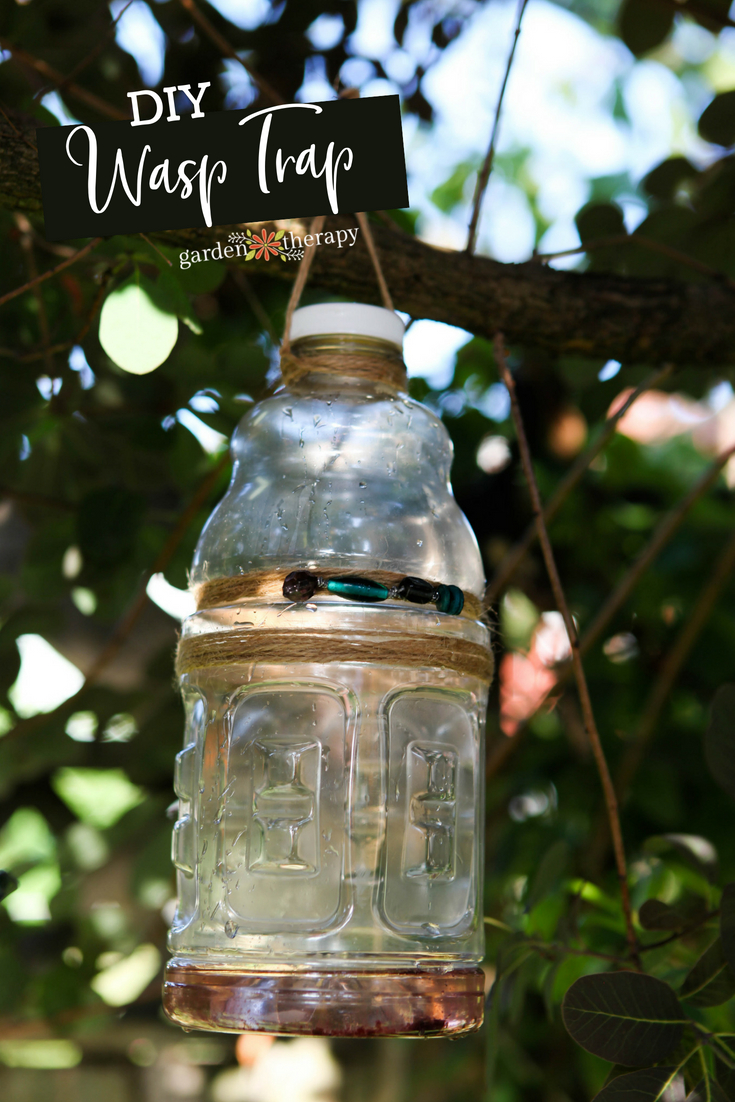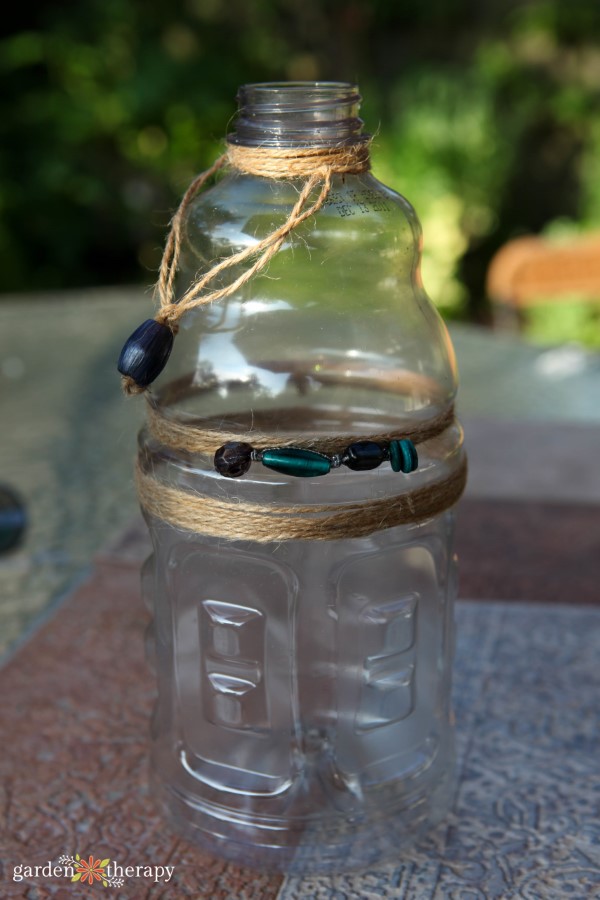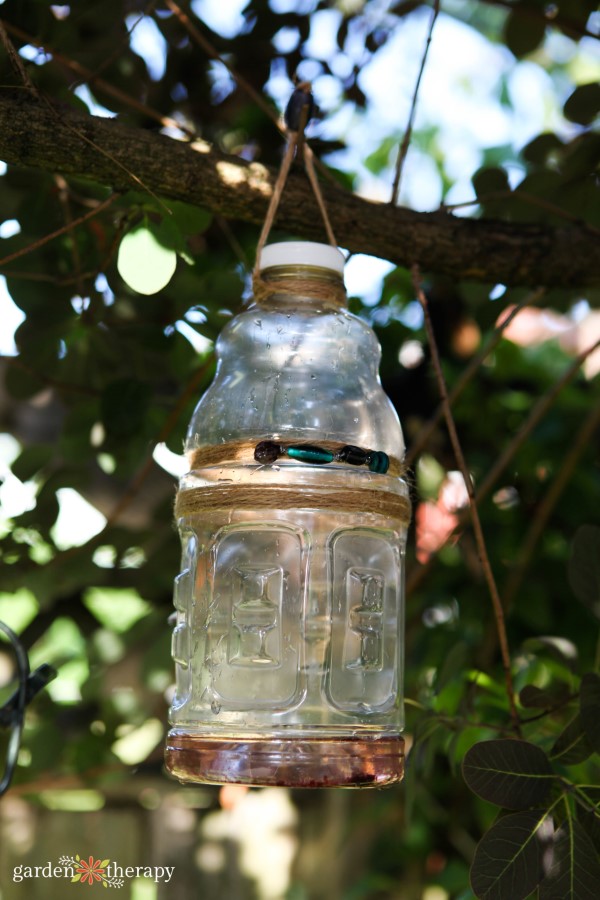Ah, summer! The perfect time of year to relax outside with friends and family by packing a picnic. But what’s that buzzing around the food? Hey, these guys weren’t invited! If wasps and yellow jackets are driving you bananas while trying to enjoy a meal outdoors, then you will love this 15-minute DIY wasp trap using a recycled bottle. That wasp won’t know what hit it.

I’m a pro-insect kinda gal. I get excited when I see a snail cruising along my stepping stones or ants feeding on the sap from my peonies. It makes me happy to see that my garden is a thriving ecosystem. And bugs are a part of that ecosystem.
Did you know that wasps are also extremely important pollinators? Figs wouldn’t be here if it weren’t for the fig wasp! They also play a part in the food chain, eating other pests you wouldn’t want to see in the garden.
But, I won’t lie that finding that tenderness for wasps is harder. They can get nasty and territorial, and when a nest takes over an important part of the garden, it may be time to take some action.
I have not one, but TWO awesome wasp traps you can make for outdoors as well as inside. The recycled bottle wasp trap’s simple yet ingenious design is easy to make with a humble plastic bottle from the recycling bin. This design makes it easy for pests to enter, but they can’t find their way out.
This post will cover…
- Insect Bait Recipes
- House Flies
- Wasps
- Brown Marmorated Stink Bugs
- DIY Hanging Wasp Trap for Outdoors
- Materials
- Make It!
- Homemade Indoor Wasp Trap
- Materials
- Make It!
- Frequently Asked Questions About Wasp Traps
- More Posts You Might Like

Insect Bait Recipes
You can use either of these traps for more than just wasps! The trap can be customized to attract different pests depending on the bait you use to lure them. Here are some suggestions.
House Flies
Flies enjoy rotting meat and decaying material. Add raw meat or fish and water to the trap. Set it in a sunny location where flies are prevalent. The sun will quickly spoil the meat and release the perfect aroma to attract flies.

Wasps
Wasps look for protein sources early in life and switch to preferring sugary treats at the end of their life cycle. At the beginning of wasp season, place cooked or raw meat or fish in an inch of water. At the end of the season, dilute some jam or mashed fruit in a bit of water.
Brown Marmorated Stink Bugs
Place a small, battery-operated LED light at the bottom of the bottle and set it in a dark place. If the light is waterproof, you can add water to drown the stink bugs. If the light isn’t waterproof, don’t use water. They still won’t be able to get out of the trap, but you will have live stink bugs to contend with in the morning.

DIY Hanging Wasp Trap for Outdoors
This first wasp trap is the ultra-simple method. It works great to hang outdoors from tree branches, fences, awnings, or wherever else your wasps tend to hang around.
Materials
- Plastic bottle with a raised dimple in the bottom
- Box cutter or drill
- Twine or wire
- Beads and yarn to decorate (optional)

Make It!
1. Choose a bottle for this project that has a bottom with a raised center. The goal is to create a trough in the bottle around the hole to hold the liquid. The center must be raised enough to allow the wasp to fly in, then get trapped and drown in the liquid-filled trough around the hole.

2. Using the box cutter or drill, make a hole about 3/4″ in diameter in the bottom of the bottle, where it is raised up.

3. Decorate the bottle with twine, yarn, beads, and whatever else you have lying around. Wind twine or wire around the neck of the bottle and tie in a knot above to hang the bottle from a tree.

4. Fill the trough inside the bottle with a bit of jam dissolved in water. Late in the season, wasps are looking for a sweet treat (while earlier in the season they want proteins).
You’re done! Bye bye wasps.

Homemade Indoor Wasp Trap
Here’s another awesome wasp trap that works great for surfaces. You can use this homemade wasp trap for indoors or outside on the patio table.
Materials
- Plastic bottle
- Box cutter or scissors
- Wasp bait such as raw meat or jam

Make It!
- Cut a plastic bottle all the way around the diameter approximately one-third from the top with scissors or a box cutter.

2. Invert the top of the bottle and set it inside the cut bottom part of the bottle.

3. Add 1 inch of the insect bait recipe of your choice to the bottom part of the bottle. Be sure that there is at least 1 inch of water or liquid to drown the insects, but that solid food also pokes out above the water.

Frequently Asked Questions About Wasp Traps
At the beginning of the season, they like protein, such as raw meat or fish. At the end of the season, they like sweets such as jams and mashed fruit. Then right in the fall, they switch back to the proteins!
Many people use vinegar as a spray to deter pests in the garden. While it can help, it can also affect your plants negatively, so I would use it cautiously.
You can also use vinegar in your DIY wasp trap. Apple cider vinegar is sweet and works well end of the season for wasps.
These homemade wasp traps do a pretty good job of keeping the wasps inside. While some wasps may be able to escape, most of them won’t be able to. The liquid will weigh down their wings, making it hard for them to fly, and they will drown.
These traps are designed to seduce wasps, so yes, they do attract wasps. Will they be bringing more wasps from outside the area? Probably not. Wasps control a territory of 20 feet surrounding their nest, chasing out any wasps not belonging to their colony. Ideally, place the trap away from where people will be to avoid stings.
The average worker wasp can live for 12-22 days. Once trapped inside a trap, it can live up to 3-4 days if it doesn’t drown.

And that should do the trick! Remember to keep these homemade wasp traps away from areas you often frequent to avoid any stings.





I have trouble around my pool, so much so my grandkids are afraid to swim😰